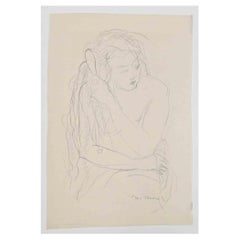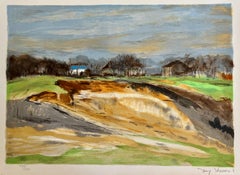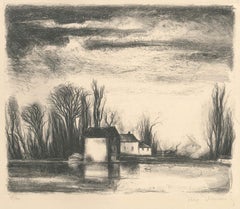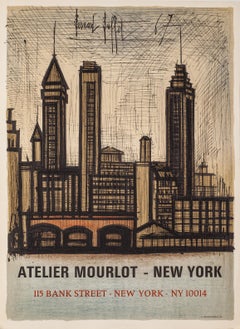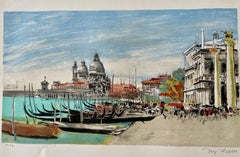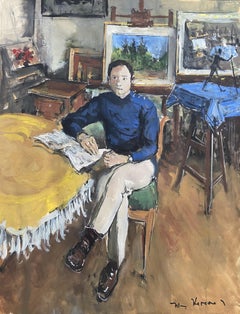Jacques Thévenet Art
French, 1891-1989
Jacques Thévenet was born in Nièvre in 1891. He studied at the Académie Julian and, after World War I in 1919, he worked as a decorator at the atelier of Marcel Mathelin, who became his master and taught him the art of engraving and the different techniques of the graphic art. In 1922, Thévenet exhibited at the Salon des Indépendants, where he met the art critic Roger Allard. Thévenet worked for several magazines, realizing the illustrations. In 1997, a catalog was published to remember his work.
to
1
3
1
Overall Width
to
Overall Height
to
4
1
3
1
2
1
1
1
1
1
1
2
2
1
1
4
9,989
2,754
1,378
1,375
1
1
Artist: Jacques Thévenet
Woman - Original Pencil Drawing by Jacques Thévenet - Early 20th Century
By Jacques Thévenet
Located in Roma, IT
Woman is an Original Pencil Drawing realized by Jacques Thévenet (1891-1989).
Good condition included a white cardboard passpartout (65x50 cm).
Hand...
Category
Early 20th Century Jacques Thévenet Art
Materials
Paper, Pencil
Nature Morte Landscape
By Jacques Thévenet
Located in Belgrade, MT
Jacques Thevenet was a French artist. He exhibited extensively throughout France and Europe and Latin America. He held several notable positions in the Paris art scene. This print is...
Category
Mid-20th Century French School Jacques Thévenet Art
Materials
Lithograph
$480 Sale Price
68% Off
The House on the Water - Original Lithograph by J. Thévenet - 1950s
By Jacques Thévenet
Located in Roma, IT
The House on the Water is an original artwork realized by Jacques Thévenet in the XX Century.
Original lithograph on paper. Hand-signed in pencil on ...
Category
Mid-20th Century Jacques Thévenet Art
Materials
Etching
The Road With Trees - Lithograph by Jacques Thévenet - Early 20th Century
By Jacques Thévenet
Located in Roma, IT
The Road With Trees is a print realized by Jacques Thèvenet in the early 20th Century.
Lithograph on paper.
Hand-signed, Numbered, edition of 6/40 p...
Category
Early 20th Century Modern Jacques Thévenet Art
Materials
Paper, Lithograph
Related Items
Atelier Mourlot - New York (NYC Skyline) by Bernard Buffet
By Bernard Buffet
Located in New York, NY
Arches Poster Paper - Perfect Condition A+
When The Mourlot Studio opened a branch in New York City, after a successful exhibition organized by the Smithsonian Institute in 1963, it...
Category
1960s Modern Jacques Thévenet Art
Materials
Lithograph
Les Montgolfieres, Place de la Concorde, Paris
By Fanch (Francois Ledan)
Located in San Francisco, CA
This artwork titled "Les Montgolfieres, Place de la Concorde, Paris" 1987 is a original colors lithograph on Arches paper by French artist (Fanch, Francois Ledan, born 1949) It is hand signed and numbered 67/250 in pencil by the artist. The image size is 25.25 x 19.5 inches, framed is 37.25 x 31.25 inches. Printed by Atelier d'Art Dejobert, Paris, with their blind stamp at the lower left corner. Custom framed in a wooden gold frame, with off white matting. It is in excellent condition.
About the artist:
Francois "Fanch" Ledan (b. 1949) is noted for colorful scenes of his native Brittany. In 1968 he abandoned his studies in commercial design for full-time studies in painting and fine art. His talent was quickly recognized and soon he was involved in major European shows. He became involved in printmaking in 1973 when he learned lithography in Paris. Since then he has had numerous one-person shows in Europe, North America and South America.
His paintings and lithographs from the 1970's and 1980's display characteristics often associated with "naïve" art. His views of Paris, a city which has embraced naïve art, display the attention to detail,
In the 80's he turned to more brightly colored paintings and again a connection to Impressionism. He began to work on paintings that he refers to as "interior...
Category
Late 20th Century Modern Jacques Thévenet Art
Materials
Lithograph
$1,233
H 37.25 in W 31.25 in D 1.5 in
Courtyard
Located in Genève, GE
Ed: 28/300
Paper glue to cardboard
Dimension with frame : 145 x 83.5 x 3.7 cm
This captivating painting depicts an interior space marked by a striking interplay of light and shadow. ...
Category
Mid-20th Century Modern Jacques Thévenet Art
Materials
Lithograph
Ocean View Wind Patterns, Camden Maine
By Yvonne Jacquette
Located in Lyons, CO
Color lithograph, Edition 30.
Jacquette also creates compelling images of the landscape and the sea from the air or atop hills or mountains. In this colorful print she depicts a view of the Maine...
Category
2010s Contemporary Jacques Thévenet Art
Materials
Lithograph
As the Moon Rises
By Susan Hall
Located in Lyons, CO
Color lithograph with pochoir, Edition25
Susan Hall lived and worked for many years in New York City before returning to her childhood home in Point Reyes Station, California. She depicts moments suspended in the mysterious light of this place of marshland, wave-broken coast line and tawny, rolling hills.
In Susan's latest prints Solitary Oak and As the Moon Rises...
Category
21st Century and Contemporary Contemporary Jacques Thévenet Art
Materials
Lithograph
The River at Belfast, Maine
By Yvonne Jacquette
Located in Lyons, CO
Color lithograph, Edition 30.
Jacquette creates compelling images of the landscape and the sea from the air or atop hills or mountains.
Category
2010s Contemporary Jacques Thévenet Art
Materials
Lithograph
Prodigal Son
By Thomas Hart Benton
Located in London, GB
A man raises his hand to his chin, his neck tilted and face turned to look at a dilapidated farmhouse, barely held together by planks of wood and exposed to the elements. Behind him ...
Category
1930s American Modern Jacques Thévenet Art
Materials
Lithograph
'Financial District', New York City — American Modernism
By Howard Norton Cook
Located in Myrtle Beach, SC
Howard Cook, 'Financial District', lithograph, 1931, edition 75, Duffy 155. A fine, richly-inked impression, on cream wove paper, the full sheet with wide margins (2 3/4 to 5 5/8 inches), in excellent condition. Image size 13 5/16 x 10 3/8 inches (338 x 264 mm); sheet size 23 x 16 inches (584 x 406 mm). Matted to museum standards, unframed.
Literature: 'American Master Prints from the Betty and Douglas Duffy Collection', the Trust for Museum Exhibitions, Washington, D.C., 1987.
Collections: Crystal Bridges Museum of American Art, Library of Congress, Metropolitan Museum of Art, Philadelphia Museum of Art, Smithsonian American Art Museum.
ABOUT THE ARTIST
Howard Norton Cook (1901-1980) was one of the best-known of the second generation of artists who moved to Taos. A native of Massachusetts, he studied at the Art Students League in New York City and at the Woodstock Art Colony. Beginning his association with Taos in 1926, he became a resident of the community in the 1930s. During his career, he received two Guggenheim Fellowships and was elected an Academician in the National Academy of Design. He earned a national reputation as a painter, muralist, and printmaker.
Cook’s work in the print mediums received acclaim early in his career with one-person exhibitions at the Denver Art Museum (1927) and the Museum of New Mexico (1928). He received numerous honors and awards over the years, including selection in best-of-the-year exhibitions sponsored by the American Institute of Graphics Arts, the Brooklyn Museum, the Society of American Etchers, and the Philadelphia Print Club. His first Guggenheim Fellowship took him to Taxco, Mexico in 1932 and 1933; his second in the following year enabled him to travel through the American South and Southwest.
Cook painted murals for the Public Works of Art Project in 1933 and the Treasury Departments Art Program in 1935. The latter project, completed in Pittsburgh, received a Gold Medal from the Architectural League of New York. One of his most acclaimed commissions was a mural in the San Antonio Post Office in 1937.
He and Barbara Latham settled in Talpa, south of Taos, in 1938 and remained there for over three decades. Cook volunteered in World War II as an Artist War Correspondent for the US Navy, where he was deployed in the Pacific. In 1943 he was appointed Leader of a War Art Unit...
Category
1930s American Modern Jacques Thévenet Art
Materials
Lithograph
$12,000
H 13.32 in W 10.38 in
Aloha Lahaina (Lahaina Harbor)
By Guy Buffet
Located in San Francisco, CA
This artwork titled "Aloha Lahauna (Lahauna Harbor)" c.1990 is an original color lithograph on paper by noted French artist Guy Buffet, 1943-2023. It is hand signed and numbered A/P ...
Category
Late 20th Century Modern Jacques Thévenet Art
Materials
Lithograph
Sugar Cane Day, Hawaii
By Guy Buffet
Located in San Francisco, CA
This artwork titled "Sugar Cane Day, Hawaii" c.1985, is an original color lithograph on paper by noted French artist Guy Buffet, 1943-2023. It is hand signed and numbered 404/425 in ...
Category
Late 20th Century Modern Jacques Thévenet Art
Materials
Lithograph
Down the River
By Thomas Hart Benton
Located in London, GB
In this sentimental work from 1939, Benton expresses his admiration for the rural lifestyle of the Midwest. He highlights the connection between man and the land by depicting two fig...
Category
1930s American Modern Jacques Thévenet Art
Materials
Lithograph
Pau Hana
By Guy Buffet
Located in San Francisco, CA
This artwork titled "Pau Hana" c.1990 is an original color lithograph on paper by noted French artist Guy Buffet, 1943-2023. It is hand signed and numbered H.C. 1/10 in pencil by the...
Category
Late 20th Century Modern Jacques Thévenet Art
Materials
Lithograph
Previously Available Items
View of Venice
By Jacques Thévenet
Located in Belgrade, MT
Jacques Thevenet was a French artist and exhibited extensively throughout France, Europe and Latin America. This lithograph is a beautiful View of Venice , very detailed an is part o...
Category
20th Century Modern Jacques Thévenet Art
Materials
Lithograph
Jacques Thevenet (1891-1989) Portrait of a man in the studio, signed Gouache
By Jacques Thévenet
Located in Paris, FR
Jacques Thevenet (1891-1989)
Portrait of a man in the studio
Gouache on paper
Signed lower right
64 x 49 cm
Framed 77 x 62 cm, some damages to the frame as visible on the photographs
Jacques Thévenet was born in Montquinon 17 October 1891, in the family’s ancestral home, built by his great grand-father, Auguste Hugues Claude Thévenet, lawyer from Château-Chinon.
He had 3 sisters and lost his mother in 1895 when he was only four. His father Louis moved the family to Paris where he run a law practice.
Young Jacques studied at the Lycée Carnot and later attended the École de droit of the Sorbonne University. Simultaneously, he attended the Académie Julian, with several painters such as Amédée de la Patellière, Jean Crotti...
Category
1960s Modern Jacques Thévenet Art
Materials
Gouache
Jacques Thévenet art for sale on 1stDibs.
Find a wide variety of authentic Jacques Thévenet art available for sale on 1stDibs. You can also browse by medium to find art by Jacques Thévenet in paper, etching, gouache and more. Much of the original work by this artist or collective was created during the 20th century and is mostly associated with the modern style. Not every interior allows for large Jacques Thévenet art, so small editions measuring 11 inches across are available. Customers who are interested in this artist might also find the work of Daniel Ginsbourg, Buscot, and Maurice Chabas. Jacques Thévenet art prices can differ depending upon medium, time period and other attributes. On 1stDibs, the price for these items starts at $99 and tops out at $981, while the average work can sell for $222.
